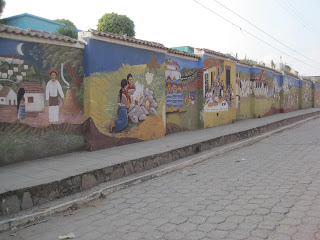 |
| School building, Long Way Home |
We went to Comalapa to visit a non-profit called Long Way Home, led by friends of ours from home. It is an initiative to build out of recycled materials including tires, glass and plastic bottles, all encased in mud and wattle. We saw organic-looking round buildings, with arched entrances. At any time, I expected the
Comalapa has good art karma. It is a smaller city, tucked into the hills and inhabited mainly by Kak’chikel Maya people. Guatemala’s National Anthem was written by a resident, and there are many visual artists, known and unknown, living here. Unknown artists include large numbers of women who weave their clothing with fabulous flowers across the bodice and back, surmounted by a row of smaller flowers around the neck. The designs of the San Juan Comalapa “huipiles” are renowned.
On the main street is a series of murals telling the history of Guatemala, from the early Mayans to Spanish conquistadores, to the conflict in the 1980s and 1990s which some call Civil War but others call the genocide. It includes a section on dreams for the future of the region.
 |
| Mural: “Urban and Rural Development Council: Weaving our Future" |
Communities like Comalapa were almost destroyed in the genocide. Right-wing government soldiers drove the people out of their communities and into hiding in the hills. , but the Mayan people ended up caught in the crossfire. The efforts at Comalapa mark a beginning of truth-telling about the genocide that has not yet taken place. The perpetrators are still in power.
 |
| Huipiles, market day, Comalapa |
 |
| Selling patterns and thread, Comalapa |
 |
| Friends at the market |
As we wandered through the market at Comalapa, I could only think COLOR. My entire field of vision
 |
| Hopeful seller |
People eat out infrequently in Comalapa. We went to one of the only restaurants, owned by a friend of ours. The only other guests greeted us individually as they left. Coffee is not the beverage of choice either. When we went to the only coffee shop in town to assuage our coffee addictions, the owner was happy to see us. I asked whether people drank much coffee in town. “Not yet”, he said. He wiped the dust off the table and moved histoddler out from the galley kitchen to start up the pot. I think we were the only customers of the day.

No comments:
Post a Comment